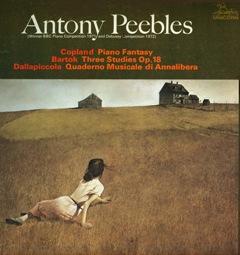Copland-Bartok-Dallapiccola - Antony Peebles – Piano Recital (1971)
Copland-Bartok-Dallapiccola - Antony Peebles – Piano Recital (1971)

Copland - Piano Fantasy A1 Piano Fantasy Bartok - Three Studies, Op. 18 B1 Allegro Molto B2 Andante Sostenuto B3 Rubato - Tempo Giusto Dallapiccola - Quaderno Musicale Di Annalibera (1952) B4 Quaderno Musicale Di Annalibera Antony Peebles – piano
My Piano Fantasy, completed in January of this year, is a large-scale work in one movement, lasting half an hour in performance. A long and continuous one-movement form has always seemed to me one of the most taxing assignments a composer can undertake. The word assignments perhaps ill-chosen, since this particular task was self-imposed. My idea was to attempt a composition that would suggest the quality of fantasy, that is, a spontaneous and unpremeditated sequence of "events" that would carry the listener irresistibly (if possible) from first note to last, while at the same time exemplifying clear if somewhat unconventional structural principles.
The Piano Fantasy was commissioned by the Juilliard School of Music as part of its fiftieth anniversary celebration. Because the work was not ready in time for performance, as originally planned, at the special series of concerts held in February, 1956, to memorialize that event, the Juilliard administration has arranged a special concert for its presentation on Friday. ---Aaron Copland, nytimes.com, 1957
Bela Bartok wrote his 3 etudes for piano in Rákoskeresztúr, Hungary in 1918. No 1 is a study in disjunct chromaticism; tiring to the hand. No 2, extended arpeggios and a melody in 3 octaves. No 3, rapid figurations and capriciously placed chords. Bartok admitted, "I cannot play the three Etudes. I haven't played them—ever or anywhere—since 1918." --- pianostreet.com
The compositional technique of cross partitioning is one of Luigi Dallapiccola's most used twelve-tone devices. Through a detailed analysis of three contrapuntal canonic movements from Dallapiccola's Quaderno Musicale di Annalibera, I examine his use of cross partitioning as a motivic tool and as a referential collection. The development of the BACH motive and the derivation of tone-row statements reflects on Dallapiccola's extensive use of cross partitioning and his compositional principles used to achieve a sense of polarity. Upon a preliminary analysis based on set-theory analysis set out by Joseph Straus I draw an interpretive analysis through Alegant's cross partitioning model as well as develop my own set of parameters for interpretation in regards to polarity which is based on intervallic stability. --- Jacqueline Ravensbergen, ruor.uottawa.ca
download (mp3 @320 kbs):
uploaded yandex 4shared mega mediafire zalivalka cloudmailru oboom uplea








